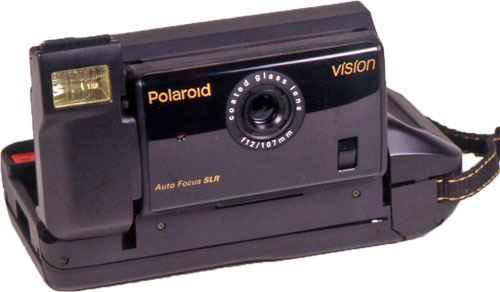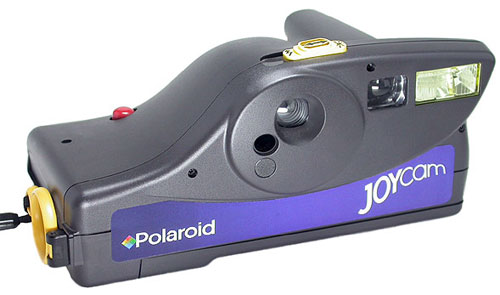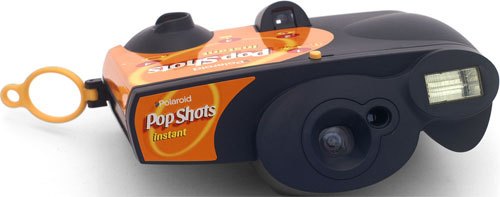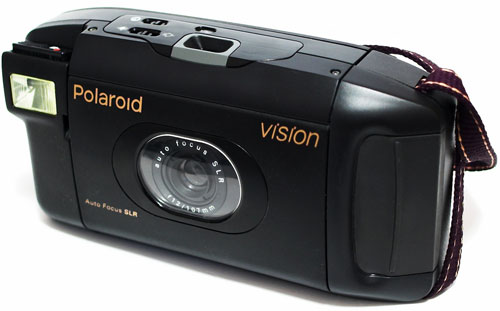Choose a model to see more information about it. Clicking on a film type will bring you to the specific page for that type. |
|---|
Captiva/Vision Cameras
The following technical information is useful for specifics concerning each model. Where appropriate you can click to see more information including photos.
All of these models take the 500 integral film.
Please see this chart to give you a visual comparison between the major "options" and abilities of each packfilm model.

If you see this icon, the model was intended for "Special Markets" distribution (i.e. corporate premiums, prizes, and other non-retail distribution) only.

If you see this icon, the model was sold in International (non-USA) markets only.
Produced: 1993-1997 (?) / Original Retail: $???.??
- Lens: 107mm f/12 3-element plastic.
- Shutter: electronic; range 1/4 - 1/180 sec.
- Automatic focus; non-Sonar; only 2 focus zones. Minimum "focus" 2 ft.
- No manual focus control possible
- SLR (Single-Lens Reflex) design.
- Built-in automatic electronic flash (cannot be overridden manually).
- Pictures are ejected into a see-through "storage chamber" in the back of the camera; pictures can be left in the chamber- or removed at any time.
- Built-in self timer.
- Body folds up to reasonably compact size; folding style much different than the SX-70; folded size is larger than that of the SX-70 (but a bit less unwieldly in shape than the SLR 680/690).
Note: "SE" version of this camera has a glass lens whereas the lens on the "regular" Captiva is made of plastic.

Produced: 19??-Present / International Markets
Produced: 1999-Present / Original Retail: $24.95 (?)
This camera is similar in basic features to the PopShots camera, but is fully reloadable, is slightly larger in overall size, and has a different control layout (it's arranged sort of like an 'upside down' PopShots). The built-in flash unit appears to have a somewhat larger reflector as well. This model was originally only sold in the Japanese market (?), but has more recently (8/99) been introduced for world-wide distribution.
Notes: If I was to assemble a list of Polaroid camera "turkeys", it would be a short list indeed (Polaroid cameras are generally pretty darn well designed), but this camera would probably be sitting right at the top of that Hall of Shame. Eeesh. Frankly, this thing suffers from a number of (in my opinion) poor design choices. For example, the only thing holding the film door closed is a thin plastic tab which barely grips two tiny little nibs on the base of the camera. Another example is placement of the wrist strap-- it's attached to the pull-ring that ejects the film. [Can you see the problem already..?] The fact that the film door is fastened to the camera solely by means of a self-adhesive (paper!) sticker is about the least of this camera's ills. Plus, the general fit-and-finish seems inferior to any other Polaroid camera-- even the PopShots disposable camera is/was better.
Produced: 1999-2001 / Original Retail: $19.95 (?)
This is a single-use (i.e. "disposable") camera using Captiva film.
- Lens: (unknown; appears to be a single-element plastic lens of less than 100mm focal length)
- Shutter: electronic; range (unknown)
- Fixed focus
- Built-in electronic flash
- Flash must be switched on or off manually, but flash exposure appears to be automatic (as opposed to most simple cameras which have fixed exposure for flash).
- Flash/Daylight switch also changes the lens aperture via a simple "Waterhouse" stop.
- Print ejection is manually operated by a pull-ring at the side of the camera.
- Camera is not intended for user reloading, but the camera is packaged with a prepaid mailer (USA) for return to Polaroid Corp. for recycling. Customer is sent a refund coupon in exchange for the returned camera. [The version of this camera sold in Europe instead directs the customer to return the camera to their local dealer, for which Polaroid will make a small contribution to a charitable organization.]
Notes: This rather unassuming camera quietly manages a few minor 'firsts', such as: (a) the first single-use instant camera ever offered, and (b) the first Polaroid integral-print camera sold in the USA to not have motorized print ejection.




Option-al Landlist
Rollfilm
Cameras
Accessories
Film
Packfilm
Cameras
Accessories
Film
SX-70
Cameras
Accessories
Film
600/779
Cameras
Accessories
Film
Spectra
Cameras
Accessories
Film
Oddballs
Cameras
Accessories
Film
Polavision
Cameras
Accessories
Film
All Films
All Cameras
All Accessories
The FAQ
Contact me…